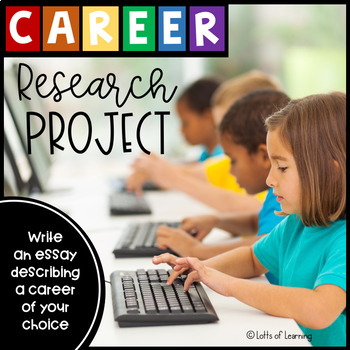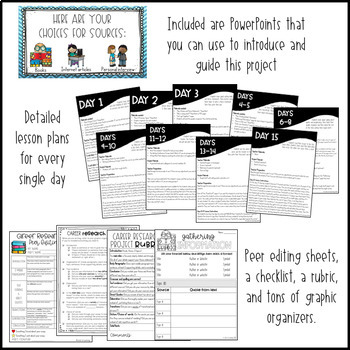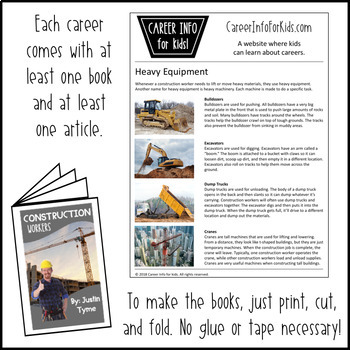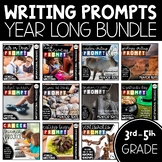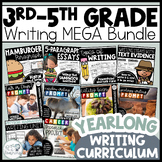3-Week Career Research Writing Project with Printable Books and Articles
- Zip
What educators are saying
Also included in
- This 3rd, 4th, 5th grade writing prompt bundle is a year's worth of writing prompts that come with paired passages/articles. No more searching for informational texts to go with your opinion/argumentative or informative/explanatory writing prompts! Each writing prompt comes with at least two informaPrice $36.50Original Price $62.00Save $25.50
- If you are teaching 3rd grade writing, 4th grade writing, or 5th grade writing this year (in a classroom or homeschooling), then this curriculum will be a huge time-saver. Whenever you need to teach a new writing skill such as paragraph writing, 5-paragraph essays, opinion writing, informational wriPrice $68.00Original Price $115.75Save $47.75
Description
This 3-week career research project includes everything you need to do research writing in 3rd grade, 4th grade, or 5th grade. When I say everything, I mean EVERYTHING. If you don't have access to books or online articles, I have included some that you can easily print and use. Please click the preview to see what this product includes.
WHAT'S INCLUDED
- Printable books for five careers
- Online articles for all five careers
- Detailed lesson plans
- PowerPoints that make teaching this project easier for you and engaging for the students.
- A schedule
- Rubric
- A writing process handout
- A tracking sheet so you can keep track of who is doing what
- Digital version of tracking sheet
- 3 different graphic organizers/outlines
- Interviewing sheets
- A "Gathering Information" page that students use while reseraching
- An "Interview Questions" page. Students write their questions on this sheet before the interview. Then, when it's time to do the interview, they write the person's answers on this page. I've had many students choose to interview someone for their career research project. For example, those that chose to research teachers came and interviewed me. Those that were researching principals, went and interviewed the principal. Those that researched a relative's career, interviewed their relative.
- A citing text evidence handout
- Checklist
- Rough Draft Paper
- ARMS handout
- Peer editing sheets
- Writing Conference forms
- Final draft paper
- Publishing Covers
- A note that can be sent home to parents to announce sharing day
- EDITABLE DOCUMENTS! That's right! If you want to make changes to some of my documents, YOU CAN! The following documents CAN BE EDITED: schedule, rubric, peer editing sheets, writing conference forms, different ways to cite text evidence handout, 5 paragraph graphic organizer/outline, and note home to parents.
Please note that this writing project is just part of my informational and opinion writing bundle. Click HERE to get more writing prompts just like this but at a discount price!
PROJECT OVERVIEW
Students spend three weeks researching a career of their choice by reading books, online articles, and/or interviewing someone. If you do not have the time or the resources to access career books, I have included some for you. The books I have included cover five different careers. (Teachers, firefighters, doctors, forensic science technicians, and construction workers.) The books are so easy to make. Each book is one page, and all you have to do is print them, cut a slit in the middle of the page, and then fold them. No glue or tape is necessary! For each career, there is at least one online article that you can print off as well. (I have used a made-up website.) As the students research their career, they take notes in one of the graphic organizers. Then they use the information they gathered and organize it into a five-paragraph outline. After they have filled in their outline, they write their rough draft on the rough draft paper I have included. Then they peer edit each others' papers using a peer editing sheet. While editing each others' papers, students check for content rather than grammar and spelling errors. After they have edited each others' papers, you take their essays home and edit them. Then you spend a couple days meeting with the students, teaching them how they can improve their essays. Then the students write their final drafts, write their sources, and design/decorate a cover.
PROJECT DAY-TO-DAY SCHEDULE
Day 1 (Monday) Go over the project with the students. Students should start thinking about what career they want to research. Student homework: Have a career chosen.
Day 2 (Tuesday): Students share what career they have chosen. Teach students how to find topics. The students should choose their three topics before the end of class.
Day 3 (Wednesday): Teach students how to write a hook and thesis statement. Students write a hook and thesis statement in their graphic organizer. Student homework: Those that need to interview someone should schedule an appointment today. They should try and schedule their interview for Friday, Saturday, or Sunday.
Days 4-5 (Thursday and Friday): Teach students how to find supporting details. Students look through books and articles to gather information for their topics. They take brief notes and write down their sources. Those that are interviewing someone learn how to have good manners while interviewing and how to ask good questions. They also write down their interview questions. Student homework: do your interview BEFORE MONDAY!
Days 6-8 (Monday-Wednesday) Students finish their graphic organizers and begin writing their rough drafts. Student Homework: Finish your rough draft if you didn’t in class.
Days 9-10 (Thursday-Friday): Students peer edit each other’s papers.
TEACHER HOMEWORK: Edit their papers over the weekend.
Days 11-12 (Monday-Tuesday) Conferences: Meet with the students individually, or in a group, to discuss their essays.
Days 13-14 (Wednesday-Thursday) Students write their final drafts. Student homework: Finish your final draft at home if you didn’t in class, so you can participate when it’s time to share essays.
Day 15 (Friday): SHARING PARTY! A few students share their essay with the whole class. When they are done reading their essay, they call on a few students to share what they liked about their essay. The students give them a class cheer.
WHAT'S INCLUDED (IN DETAIL)
When you purchase this product, you will receive the following:
-Printable books for five careers (elementary teachers, high school teachers, secondary teacher, firefighters, doctors, forensic science technicians, and construction workers.)
-Online articles for all five careers (the website is made-up)
-Detailed lesson plans that explain what you will need, what the students will need, how to prepare for each lesson, and detailed instructions on how to teach each lesson
-PowerPoints that make teaching this project easier for you and engaging for the students. These PowerPoints are very detailed. They introduce the project in a fun way. They teach the students how to write a hook and thesis statement. They teach students how to pick three topics. They teach the students how to gather information and why it's important to keep track of where they get their info. And last, but not least, they teach students how to cite their information. To really help the students understand what they should and shouldn't do each day, I have created a character named George. Throughout all of these PowerPoints, George is used as an example. He chose to write his essay about doctors because his mom is a doctor. Throughout these PowerPoints, students learn from the things that George did well and the things that George needs to fix. If there is anything that George needs to fix, the students help fix it. To keep the students engaged and learning, my PowerPoints expect the students to discuss often. So if you like peer discussion, then you will like these PowerPoints!
-A schedule that outlines what the students will be doing each day
-A rubric so the students can know what they will be graded on from the very beginning. It also makes grading these papers fairly easy.
-A writing process handout
-A tracking sheet so you can keep track of who is doing what
-A tracking sheet in PowerPoint form so you can keep track of who is doing what digitally. This is my favorite way of keeping track of who is doing what because I can fill in the table in front of the students. When students see what their peers are researching and doing, it keeps them accountable and motivated. It also helps keep you on top of who is doing what. :)
-3 different graphic organizers/outlines. Students write their hook, thesis, topics, and details in these outlines.
-"Let's get Together" sheets. These are for the students who want to interview someone to get more information. Students fill out one of these pages and then use them to schedule an interview.
-A "Gathering Information" page. Students fill in this graphic organizer while they are researching books and/or articles. Each time they come across information that they want to use, they write it down in this sheet.
-An "Interview Questions" page. Students write their questions on this sheet before the interview. Then, when it's time to do the interview, they write the person's answers on this page. I've had many students choose to interview someone for their career research project. For example, those that chose to research teachers came and interviewed me. Those that were researching principals, went and interviewed the principal. Those that researched a relative's career, interviewed their relative.
-Two different handouts that demonstrate how to cite text evidence. (Both handouts give examples for citing direct quotes and paraphrasing.)
-A handout that shows how George did his first two paragraphs. Students can refer to George's paragraphs to guide their own writing.
-A checklist that the students can use to make sure they've done everything. (The checklist includes everything that's in the rubric.)
-Rough Draft Paper (lined paper that has revision checkboxes at the bottom. There are lots to choose from.)
-ARMS handout. (ARMS is a handy acronym that can be used during the revision step of the writing process. It stands for add more detail, remove unnecessary words or phrases, move things around, and substitute boring words.)
-Peer editing sheets. I LOVE using these! Instead of having the students write all over each others' papers with red pens, students use one of these forms. To use these forms, students swap rough drafts and then go through and answer each question that is on the form. They don't worry about grammar or spelling. They just check to see if their peer did or did not do each item.
-Writing Conference forms. These forms are for you. They can be used while you are editing the students' essays. When you come across something a student needs to work on, you write their name in that category. Later, when it's time for conferences, you already have your groups arranged.
-Decorative lined paper for final drafts
-Decorative covers with various careers
-A note that can be sent home to parents to announce sharing day. (A day where students get to bring an item from home and read their essays to the class.)
-Sample essays (one for doctors and one for construction workers.)
-EDITABLE DOCUMENTS! That's right! If you want to make changes to some of my documents, YOU CAN! The following documents CAN BE EDITED: schedule, rubric, peer editing sheets, writing conference forms, different ways to cite text evidence handout, 5 paragraph graphic organizer/outline, and note home to parents.
The Standards
This resource is aligned with the following standards:
3rd grade:
Research to Build and Present Knowledge:
CCSS.ELA-LITERACY.W.3.7Conduct short research projects that build knowledge about a topic.
CCSS.ELA-LITERACY.W.3.8Recall information from experiences or gather information from print and digital sources; take brief notes on sources and sort evidence into provided categories.
CCSS.ELA-LITERACY.W.3.9(W.3.9 begins in grade 4)
4th grade:
Research to Build and Present Knowledge:
CCSS.ELA-LITERACY.W.4.7Conduct short research projects that build knowledge through investigation of different aspects of a topic.
CCSS.ELA-LITERACY.W.4.8Recall relevant information from experiences or gather relevant information from print and digital sources; take notes and categorize information, and provide a list of sources.
CCSS.ELA-LITERACY.W.4.9Draw evidence from literary or informational texts to support analysis, reflection, and research.
5th grade:
CCSS.ELA-LITERACY.W.5.7Conduct short research projects that use several sources to build knowledge through investigation of different aspects of a topic.
CCSS.ELA-LITERACY.W.5.8Recall relevant information from experiences or gather relevant information from print and digital sources; summarize or paraphrase information in notes and finished work, and provide a list of sources.
CCSS.ELA-LITERACY.W.5.9Draw evidence from literary or informational texts to support analysis, reflection, and research.
© Lotts of Learning

